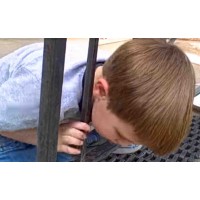Head Entrapment on the Playground

Public Playground Safety Handbook CPSC Publication 325 U.S. Consumer Product Safety Commission 3.3 Entrapment 3.3.1 Head entrapment Head entrapment is a serious concern on playgrounds, since it could lead to strangulation and death. A child’s head may become entrapped if the child enters an opening either feet first or head first. Head entrapment by head-first entry generally occurs when children place their heads through an opening in one orientation, turn their heads to a different orientation, then are unable to get themselves out. Head entrapment by feet first entry involves children who generally sit or lie down and slide their feet into an opening that is large enough to permit their bodies to go through but is not large enough to permit their heads to go through. A part or a group of parts should not form openings that could trap a child’s head. Also, children should not wear their bicycle helmets while on playground equipment. There have been recent head entrapment incidents in which children wearing their bicycle helmets became entrapped in spaces that would not normally be considered a head entrapment. Certain openings could present an entrapment hazard if the distance between any interior opposing surfaces is greater than 3.5 inches and less than 9 inches. These spaces should be tested as recommended in Appendix B. When one dimension of an opening is within this range, all dimensions of the opening should be considered together to evaluate the possibility of entrapment. Even openings that are low enough for children’s feet to touch the ground can present a risk of strangulation for an entrapped child. (See Figure 4).Younger children may not have the necessary intellectual ability or motor skills to reverse the process that caused their heads to become trapped, especially if they become scared or panicked. Children have died when drawstrings on their clothing caught on slides or other playground equipment. Remove hood and neck drawstrings from children’s clothing before children play on a playground. Remove scarves and mittens connected through the sleeves. • There should be no sharp edges on slides. Pay special attention to metal edges of slides along the sides and at the exit (see also §5.3.6.4). • If steel-belted radials are used as playground equipment, they should be closely examined regularly to ensure that there are no exposed steel belts/wires. • Conduct frequent inspections to help prevent injuries caused by splintered wood, sharp points, corners, or edges that may develop as a result of wear and tear on the equipment. 3.3.2 Partially bound openings and angles Children can become entrapped by partially bound openings, such as those formed by two or more playground parts. • Angles formed by two accessible adjacent parts should be greater than 55 degrees unless the lowest leg is horizontal or below horizontal. • Use the partially-bound opening test in Appendix B to identify hazardous angles and other partially-bound openings. For more information, please contact DunRite Playgrounds!
